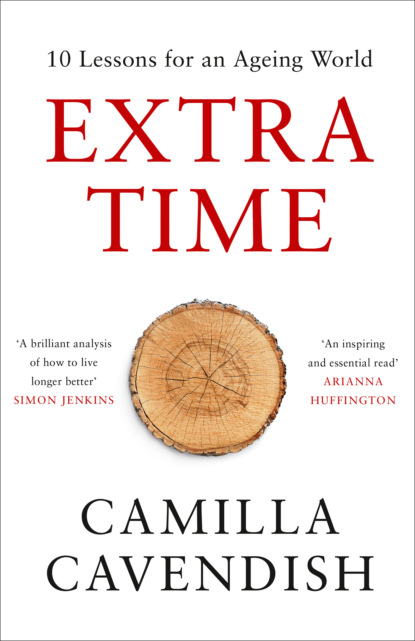По всем вопросам обращайтесь на: info@litportal.ru
(©) 2003-2024.
✖
Extra Time: 10 Lessons for an Ageing Society - How to Live Longer and Live Better
Настройки чтения
Размер шрифта
Высота строк
Поля
Will they be fit enough? China faces an increasing burden of chronic disease approaching Western levels. Junk food and stress have accompanied rapid urbanisation and the country has not yet broken the smoking habit. Under Mao, China’s population was surprisingly healthy: it saw the world’s most sustained increase in life expectancy, from 35 in 1949 to 65 in 1980.
That healthy, working-age population helped to drive its unprecedented economic growth.
But now, China is growing old with neither Japan’s wealth nor its health, at a time when many of its jobs still require physical, manual labour. And its rival, America, is on a different path.
China v America
America has long been a demographic exception, with a higher birth rate than most other rich countries. China’s population is currently around four times the size of America’s. But that gap will have halved
by the end of this century, unless America slams the door shut on immigrants.
The chart below gives a glimpse into the geopolitics of the next few decades. It shows China’s working-age population dropping, along with Europe’s, while America’s remains stable:
Before the financial crisis, the American population was sustaining itself, with a birth rate of 2.12.
This is partly because it has higher levels of immigration, and because immigrants tend to have larger families. In the US, 23 per cent of births are to foreign-born women,
while only 13 per cent of the population is comprised of immigrants.
American women also become mothers earlier than in any other OECD country: at an average age of 26, compared with 28 in the UK, and 31 in Italy. Only 14 per cent of US women remain childless, compared to 18 per cent in the UK and 23 per cent in Germany.
There is a dark side. America has been lagging behind other rich countries in life expectancy, partly because its high rates of obesity mean it has failed to combat deaths from stroke. But now, US life expectancy at birth has dropped for three years in a row, the first drop since the AIDS/HIV epidemic, partly because of what the Princeton professors Case and Deaton have dubbed ‘deaths of despair’
– from suicide, alcohol and opioids.
Poverty and inequality pose real challenges.
In 2017, America also hit a 40-year low in its fertility rate, of 1.76.
What is not clear is whether this is a post-crisis blip or a new direction. The fertility rate of Mexicans in America dropped by a third between 2006 and 2013, partly because of the financial squeeze – and it hasn’t yet recovered. If migrants are to keep working their magic on fertility, they need to keep coming, because second- and third-generation immigrants tend to adopt the cultures of the host country and have fewer babies. Any president who builds a wall could therefore get more than he bargained for: because population is shaping up to be a powerful geopolitical weapon.
India: Educating Rhia
Today’s Indian couples say their ideal family size is two children, according to a poll by The Economist.
That’s smaller than the ideal family cited by Brits and Americans. Fifty years since the biologist Paul Erhlich predicted mass famine in his book The Population Bomb, India’s youthful population is growing slowly. The average woman now has just 2.3 children – fewer if she is Sikh, Jain or Christian, slightly more if she is Hindu and a bit more again if she is Muslim.
India did not need a One-Child Policy to reach this point. Although government has nudged people to have smaller families in various ways, India is a good advert for the principle that educating girls reduces the number of children they have. Especially if you accept that education comes in many forms. Birth rates have fallen where cable TV has arrived in rural areas, bringing Bollywood soap operas featuring independent childless women and chic urban mothers with small families.
Audiences name their babies after the characters, become less tolerant of domestic violence and use contraception. India is not alone: telenovelas have had a similar effect in Brazil.
While India still wrestles with poverty and illiteracy, it seems that urbanisation, growing prosperity, public health and most of all education are powerful contraceptives.
Singapore: City Living
‘Having kids was important to our parents,’ one thirty-something civil servant in Singapore explained to researcher Joel Kotkin, who conducted extensive interviews with young professionals. ‘But now we tend to have a cost and benefit analysis about family. The cost is tangible, but the benefits are not.’
Such chilling pragmatism resonates in many parts of Asia, especially those where property prices are high. It is no accident that Singapore, Tokyo, Hong Kong, Shanghai and Beijing, some of the world’s most expensive cities, have some of the lowest birth rates. The Singapore government’s ‘Marriage and Parenthood Package’ offers substantial bonuses to couples who have children. But it’s not working too well. Many ambitious youngsters seem more focused on their careers: a third of graduates aged 30 to 34 years old are single in Singapore, and the birth rate is 1.2.
These modern workers don’t seem to worry that no one will look after them in old age. Across Asia, the traditional model of close-knit families is breaking down. Social networks are increasingly made up of friends, not relatives: reinforcing the notion that childlessness is normal.
Europe: Waiting for Mr Right?
‘Capitalism + atheism + feminism = sterility = migration,’ tweeted Julian Assange, founder of WikiLeaks and fugitive from justice, in 2017. ‘EU birthrate = 1.6,’ he went on. ‘Replacement = 2.1. Merkel, May, Macron, Gentiloni [the leaders of Germany, Britain, France and Italy at the time] all childless.’
This was a neat summary of Europe’s plight. And nowhere does it apply more strongly than in Italy, which most of us still associate with large Catholic families. The country of ‘amore’ now has the lowest birth rate in Europe. This is partly a consequence of youth unemployment. The long, grim recession since the financial crash of 2008 has seen many Italians travel abroad to find jobs, and others fearing they can’t afford children.
The average Italian woman would still like two or more children.
But she doesn’t have her first child until 31 – older than anywhere else in the EU.
One reason may be that two-thirds of Italian men under 35 are still living with their parents, in contrast to most young women.
Politicians have dubbed these Mama’s boys ‘bamboccioni’ (‘big babies’) who won’t grow up. Political commentator Antonio Politi has claimed that women are being deterred from raising families by men who are neither fulfilling their roles as breadwinners, nor stepping up to fatherhood.
Attempts to warn women not to leave it too late have backfired spectacularly. When Italy’s health minister Beatrice Lorenzin organised a national Fertility Day, with talks up and down the country, she was met with outraged counter-demonstrations. Women marched through the streets carrying placards reading ‘siamo in attesa’:
a play on the Italian for ‘we’re expecting’, which also translates as ‘we’re waiting’. Waiting for jobs, waiting for affordable childcare, and waiting for equality. Many Italian women still lose their jobs when they get pregnant; one in four is sacked within a year of having her first child.
Romance is not entirely dead, but the birth rate is in trouble when women need to work but don’t have equality.
Germany has similarly high rates of childlessness to Italy. But in Europe’s prosperous heart, this has less to do with money worries. ‘In the days of “Kinder, Küche, Kirche” [“Children, Kitchen, Church”] it was natural to have children,’ I’m told by Dr Jan Kessler, a paediatrician in Munich. ‘But that’s old-fashioned to a generation which wants to keep its options open. They want to study; they want a good career; it’s never really a good time to have a child.’
Women are enjoying success, and don’t always want to deal with old-fashioned views of motherhood. ‘No one minds me having a career,’ one married academic told me. ‘But I would get a lot of flak if I left a child in a crèche.’ Some German women fear being labelled as Rabenmütter, ‘raven mothers’, if they dare to combine work and motherhood. This appalling image, of ravens as carrion-eaters who neglect their young, seems to weigh heavily on some women, who are in any case not certain whether they want children.
The German government gives generous parental leave and has massively expanded day care. It now spends almost three times as much on benefits to families as it spends on defence.
(The UK spends about 1.3 times more.
) The reforms were led by Ursula von der Leyen, a government minister and mother of seven, who subsidised paternity leave and declared that men should be responsible for half of the childcare. And the birth rate has nudged up a little, with the help of immigrants. To keep pace, the Federal Statistical Office has estimated that the country would need half a million immigrants every year until 2040. That seems unlikely, given the backlash which followed Angela Merkel’s opening the borders to around a million refugees in 2015.
The birth rate is higher in Britain, where part-time working and maternity benefits are routine. That’s partly because of high levels of immigration: 28 per cent of live births in the UK are to foreign-born women,
though foreign-born people make up about 14 per cent of the population.
We are also breeding a nation of only children. Almost half of British families now contain only one child. It’s not clear how much of that is deliberate. In polls, Brits say their ideal family is just over two children, but the birth rate is 1.76.
Sarah Davies, a teacher, was in her mid-thirties when she plucked up the courage to ask her long-term boyfriend to settle down. He dumped her. Now, she wonders if she’s left it too late. ‘No one will fancy me if I look desperate,’ she says gloomily, staring at a dating site. Ms Davies is not one of those mythical creatures regularly accused by the UK press of ignorantly frittering away their fertility. She’s been muffling the ticking of her biological clock for years, fearing men are on a different timetable. ‘They’ve got no incentive,’ she reflects. ‘If I was a man, I’d probably focus on my career too, and not want to be hamstrung by a baby till I’d made it.’ A lack of suitable partners may explain recent increases in the numbers of single women seeking IVF, and why birth rates for women over 40 are at their highest level since 1949.
That seems more likely than the idea that highly capable career women, who stick to every other timetable, somehow ‘forgot’ to have kids.
Is Life Expectancy Stalling?
Galloping increases in life expectancy have recently slowed dramatically in the UK, and to a lesser extent in Germany, Sweden and the Netherlands. This has surprised actuaries. Some blame it on government cuts to public services, although those were not uniform in those countries.
Others believe it has more to do with a slowdown in the incredible progress we have made against heart attacks and stroke.
Life expectancy at birth grew substantially during the twentieth century, because we were reducing deaths among infants and children: but life expectancy from the age of 65 barely budged. Between 1970 and 2011, however, older people saw a dramatic change: life expectancy at 65 increased 20 times as fast as in the previous century. The main reason? A massive drop in deaths from heart attack and stroke, driven by people giving up cigarettes.





